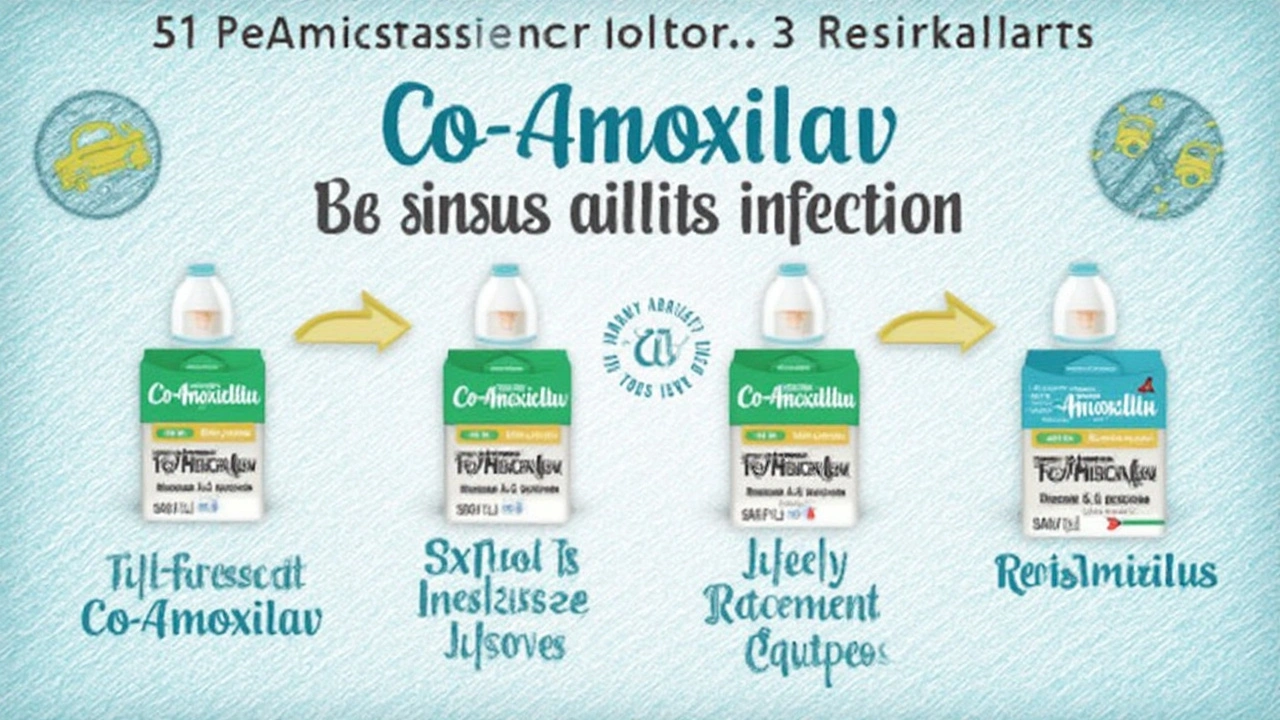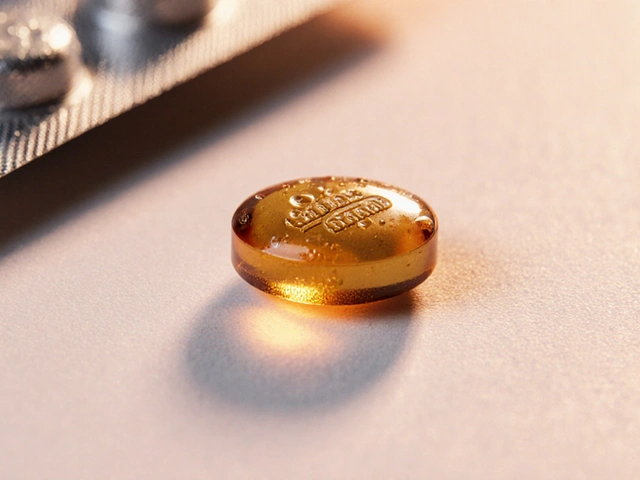How Sinus Infections Are Treated: Where Does Co-Amoxiclav Fit?
Sinus infections can really ruin your week, can’t they? That constant pounding in your face, the stuffy nose you can’t shift, and, if you’re truly unlucky, the fever and aches. Here’s the bit a lot of people don’t get: not every sinus infection needs antibiotics. A lot are viral, and they’ll just run their course. But if you’ve been hit with one that lingers for ten days or gets worse instead of better, bacterial infection is usually to blame, and that’s when your doctor might pull out the prescription pad. Co-amoxiclav—which you might know as Augmentin—comes into play when simple antibiotics don’t cut it, or when the usual ones could flop against tougher bacteria. In fact, NICE guidelines here in the UK put Co-amoxiclav as a ‘second-line’ antibiotic for acute sinusitis precisely because of its beefed-up formula: a blend of amoxicillin and clavulanic acid that knocks out many resistant bugs.
Augmentin is popular because it covers a wide range of bacteria, especially those that spit out enzymes to dodge regular amoxicillin. Think of it as the upgraded toolkit when basic fixes don’t work. But doctors don’t go straight for it unless there’s a reason—overusing strong antibiotics can encourage resistant bacteria, which means the next sinus attack could be even tougher to treat. So the big question: how does it stack up next to other antibiotics?
From my years living with Bristol’s unpredictable weather, I know sinus infections are part of the package for many people here. The damp, changing temperatures seem to set off a domino effect. You walk into a chemist coughing, and you’ll hear people talking about everything from penicillin to fancy macrolides. Co-amoxiclav often gets mentioned as a sort of last resort after the basic stuff—quite a reputation, but is it truly the heavy hitter?
Before we start this head-to-head, it’s useful to think about what 'works' means here. We're not only asking which drugs kill bacteria faster, but also which make you feel better quicker, and which ones come with fewer nasty side effects. Plus, everyone wants to know: what about cost, convenience, and the risk of triggering even more resistant bacteria next time?
Augmentin’s Biggest Rivals: Amoxicillin, Doxycycline, and Macrolides
Let’s break down the main competitors against Co-amoxiclav in the battle for sinus relief. The most widely prescribed first-line antibiotic for sinus infections in the UK and across Europe is plain old amoxicillin. Doctors like it because it’s cheap, well-tolerated, and does the job for many community-acquired cases of bacterial sinusitis—especially if resistance isn’t rampant in your area. But the drawback? Resistant strains are steadily increasing, especially among people who’ve already had plenty of antibiotics in the past year, kids in crowded classrooms, and anyone exposed to healthcare environments.
Doxycycline often comes next—particularly in adults who can’t take penicillins (think allergy concerns). It’s part of the tetracycline group, and it’s notably cheap, can be taken once daily, and causes less stomach upset than Augmentin for many people. But it’s not always a great pick for children under eight or for pregnant women because of potential tooth and bone issues.
Then there’s the macrolides category, like clarithromycin and azithromycin. These get pulled into the ring when both penicillins and doxycycline can’t be used (due to allergies, intolerances, or even resistance in some cases). Macrolides work by a totally different mechanism and have the upside of short course durations—sometimes just three to five days. That sounds nice, but recent studies have shown increasing resistance among the main sinusitis bugs, making macrolides a riskier bet in the UK compared to a decade ago. For instance, the British Society for Antimicrobial Chemotherapy pointed out in a 2024 report that macrolide-resistant Streptococcus pneumoniae now shows up in over 18% of tested isolates in southwest England.
Augmentin stands apart because it’s still able to zap some strains that amoxicillin and macrolides let slip through. It’s especially useful if your sinusitis has resisted a first course of regular antibiotics or lasted more than two weeks with nasty symptoms. But it’s not without its baggage—more on that in a moment.

Effectiveness: Which Antibiotic Actually Shifts Sinus Infections Fastest?
Everyone wants a quick fix. So, which drug clears things up the fastest—and with the fewest relapses or side effects? Solid clinical studies give us hard numbers, not just hype. In a big 2023 meta-analysis comparing thousands of sinus infections, Augmentin outperformed amoxicillin by around 15% for cases where bacteria were resistant to basic penicillins. That doesn’t mean it’s always the magic bullet, but if regular antibiotics haven’t worked, Augmentin’s combination formula seems to bump up cure rates nicely.
If you pit Augmentin against doxycycline, it’s almost a draw for cure rates—both scored nearly 90% success on post-infection follow-up across several head-to-head trials. But Augmentin offered slightly quicker resolution of facial pain and fever—sometimes by a day or two—though more patients complained about stomach issues.
Azithromycin’s famous three-day or five-day regimen sounds tempting, and for some milder infections it’s pretty effective. But cure rates dropped to the low 70s in comparison studies with drug-resistant strains, so it’s less reliable for those gnarly, stubborn sinus flares. Meanwhile, clarithromycin had similar issues—great for penicillin-allergy patients, but increasingly unreliable as resistance rises. For folks in areas with lots of macrolide resistance (including southwestern UK), these drugs should really be reserved as a last resort or for those who can’t tolerate anything else.
Here’s a quick reference on relative effectiveness based on recent trial data and local guidelines:
| Antibiotic | Cure Rate (%) | Main Pros | Main Cons |
|---|---|---|---|
| Amoxicillin | 80-85 | Cheap, low side effects | High resistance in some regions |
| Co-amoxiclav (Augmentin) | 90-94 | Deals with resistant bacteria | Stomach upset, cost |
| Doxycycline | 87-90 | Simple dosing, fewer allergies | Bad for kids, sun sensitivity |
| Azithromycin | 70-81 | Short course | Bad resistance, some cardiac risk |
Notice how Augmentin (Co-amoxiclav) does have an edge for stubborn infections, but its downsides are clear too. If your past antibiotics haven’t worked, it might be worth discussing. But don’t forget, if you’re weighing an alternative to Augmentin, you’ll need to factor in resistance levels where you live, any drug allergies you’ve got, and what your NHS local chemist can actually stock this week. No single drug is perfect for everyone.
Side Effects, Safety, and What to Expect From Each Drug
This bit really matters: how much grief is each antibiotic likely to give you while treating sinusitis? Co-amoxiclav is notorious for causing more gut-related problems—think loose stools, queasiness, and (rarely) serious gut inflammation like C. difficile colitis. In fact, about one in six people notices notable stomach upset, especially if you take it on an empty stomach or have to use it for more than a week. It’s usually recommended to take it with food for this very reason.
Amoxicillin on its own causes fewer stomach issues, though allergic rashes can still happen—especially in kids. Macrolides like azithromycin or clarithromycin can upset your stomach too, but they’ve also got a rare risk of heart rhythm problems—not what you want if you’re older or already have cardiac issues. Doxycycline’s quirks include making your skin much more sensitive to sun (which is a problem if you’re lucky enough to be taking a holiday during your dose). Plus, it’s off limits if you’re pregnant, breastfeeding, or under eight years old due to the risk to teeth and growing bones.
Longer-term safety is also a huge issue. Every course of antibiotics—even one for sinusitis—increases the risk that future infections will come back tougher, more resistant, and harder to treat. This is why UK and European guidelines push doctors to stick with the narrowest (least broad-spectrum) antibiotic possible, for the shortest effective course. That could mean a basic penicillin if possible, or avoiding antibiotics altogether for viral cases.
Some less-discussed risks: Augmentin can cause severe allergic reactions (think swelling, trouble breathing), though this is rare; make sure you tell your GP if you’ve ever had any trouble with antibiotics before. Macrolides sometimes interact with common medicines like statins or blood thinners—so keep your doctor in the loop about all your prescriptions. And never, ever try to self-medicate with leftover antibiotics at home. It’s not just about resistance; you could cause yourself far more serious problems.

Practical Tips: Getting the Most Out of Your Sinus Infection Treatment
Okay, you’ve got your hands on an antibiotic—now what? Here are some things patients rarely get told in the exam room, but wish they’d known:
- Take your antibiotic exactly as prescribed—even if you feel better after a few days. Stopping early helps resistant bugs survive and bounce back.
- If you’re on Co-amoxiclav/Augmentin, have it with food. You’re less likely to get an upset stomach or diarrhea, and you absorb it better.
- Drink loads of water. You’re fighting dehydration from congestion and fever anyway, and water helps flush out both infection and drug metabolites.
- Watch for any signs of allergic reaction with the first dose—rash, itching, swelling, shortness of breath—and get help right away if they pop up.
- If you develop severe diarrhea (especially bloody or with stomach pain), stop your antibiotic and call your GP or 111 immediately—this can be a serious side effect, not just a nuisance.
- Don’t double up on doses if you miss one—just take the next one when it’s due.
- Macrolides and some other antibiotics can interact with heart meds, anti-epileptics, and even some anti-anxiety drugs—if in doubt, check with your pharmacist.
- Think ‘sinus infection first aid’ too: steam inhalation, saline nasal rinses, and simple painkillers can speed your recovery and make antibiotics work better. Just don’t use commercial nasal decongestant sprays for more than 3-5 days, or you risk rebound congestion that’s even worse than the original stuffiness.
- If you finish treatment but the infection keeps coming back, ask your doctor whether you need to be swabbed for resistant bacteria, or if something else (like allergies or nasal polyps) is causing the trouble.
One more tip: if you’re reading this and traveling (maybe you’re backpacking round Europe or just planning a long-haul holiday), check which antibiotics you can bring legally and how to store them, especially in hot climates. Some need refrigeration; others lose strength in warm, damp conditions—so don’t just toss your meds in with your sunscreen and hope for the best.
The world of sinus infection antibiotics is changing every year. As resistance climbs and supply chains wobble, the tried-and-true may not always be an option. If Augmentin (Co-amoxiclav) hasn’t worked for you—or just isn’t available this month—ask your doctor about safe alternative to Augmentin choices and what you need to know about each. The best solution is still the one tailored to your body, your bugs, and your lifestyle. Don’t be afraid to bring up what’s worked (or flopped) for you in the past the next time you’re chatting with your GP. They’ve seen it all, and you won’t surprise them.






Comments
Patrick Culliton
28/Apr/2025Honestly, the whole hype around Augmentin feels like a marketing ploy to keep pharma profits high. If you look at the resistance data, you’ll see that tossing a broad‑spectrum combo as a “second‑line” option often just accelerates the problem. Most sinus cases clear up with a short course of amoxicillin or even just symptomatic care. Doctors should be urged to reserve Co‑amoxiclav for truly refractory infections, not as a default backup.
Andrea Smith
28/Apr/2025While I understand the concern, it’s also important to recognize that individual patient histories vary significantly. For someone with repeated failures on plain amoxicillin, Augmentin can indeed be life‑saving. Moreover, NICE guidelines exist precisely to balance efficacy with stewardship. We ought to tailor therapy rather than dismiss a useful option outright.
Gary O'Connor
28/Apr/2025Sounds like a solid overview, cheers.
Justin Stanus
28/Apr/2025The gut‑related side effects of Co‑amoxiclav are often downplayed, but they can be debilitating for many patients. I’ve seen colleagues lose weeks of productivity because a patient was stuck on a constant loop of loose stools and abdominal cramps. What makes it worse is that the drug’s efficacy hinges on taking it with food, yet many people skip meals when they feel ill. Skipping meals not only reduces absorption but also aggravates the very nausea the antibiotic provokes. In my experience, a careful conversation about diet can cut those gastrointestinal complaints in half. The alternative, doxycycline, avoids the gut issue but brings its own set of problems, like photosensitivity that ruins any outdoor plans. And let’s not forget the risk of C. difficile, which, although rare, is a nightmare scenario that can land a patient in intensive care. The cost factor also plays a role; Augmentin is noticeably pricier than the generic amoxicillin many pharmacies stock. Still, when resistance rates climb above 10 % in a region, the added expense may be justified. I’ve observed that patients who receive the right drug early avoid prolonged courses and, consequently, lower total spending. The key is to base the decision on local antibiograms rather than habit. If a clinician defaults to Augmentin without checking resistance patterns, they’re essentially gambling with both the patient and the broader community. That gamble becomes even riskier when the patient has a history of allergic reactions to beta‑lactams. In such cases, a macrolide might be the safer route, despite its own resistance concerns. Bottom line: Co‑amoxiclav works well when used sparingly and with informed consent about its drawbacks.
Claire Mahony
28/Apr/2025I appreciate the thorough breakdown of the side‑effect profile. It’s crucial to flag the C. difficile risk early, especially for patients with recent hospital exposure. Aligning treatment with local resistance data is indeed the smartest move. When prescribing, a brief discussion on food intake can mitigate many of the gastrointestinal complaints you mentioned.
Andrea Jacobsen
28/Apr/2025One point worth adding is the role of nasal irrigation alongside antibiotics. Saline rinses can physically clear mucus and reduce bacterial load, potentially shortening the needed antibiotic course. Also, staying well‑hydrated supports mucosal healing and may lessen drug‑induced dehydration. For patients worried about cost, over‑the‑counter nasal sprays are a cheap adjunct that complements prescription therapy. Finally, a short course of ibuprofen can address the facial pain while the antibiotic does its job.
Andrew Irwin
28/Apr/2025That’s a balanced view; combining non‑pharmacologic measures with the right antimicrobial seems like the most patient‑friendly approach.
Jen R
28/Apr/2025Honestly, most of this reads like textbook fluff; the real issue is that GPs often overprescribe without testing.
Joseph Kloss
28/Apr/2025The very concept of “quick fixes” in sinusitis betrays a deeper cultural impatience with natural disease processes. We have become accustomed to demanding immediate pharmacological relief, ignoring the fact that many infections are self‑limiting. When you frame antibiotics as a tactical weapon rather than a strategic reserve, you invite misuse. The data showing a 15 % advantage for Augmentin in resistant cases is compelling, yet it masks the collateral damage incurred. Every course selects for resistant flora, which, over time, diminishes our therapeutic arsenal. Moreover, the psychological reliance on pills can erode patient agency, making them less likely to pursue supportive care. A better model would emphasize shared decision‑making, where the physician presents the probability of bacterial versus viral etiology. In that context, the patient can weigh the modest benefit of a broad‑spectrum agent against the long‑term community risk. The paradox is that by treating individual symptoms aggressively, we may be compromising future health outcomes for the population. This is not merely an abstract epidemiological concern; it translates into harder‑to‑treat infections in the clinic. The economic implications are also non‑trivial, as resistant infections demand more expensive, often intravenous, therapies. From an ethical standpoint, physicians have a duty to steward antibiotics responsibly. Yet, the pressure from patients-who demand a prescription to “feel better fast”-creates a challenging tension. The solution lies in education, rapid diagnostic tools, and clear guidelines that prioritize narrow‑spectrum agents when appropriate. In summary, while Augmentin has its place, it should be deployed judiciously, with an eye toward preserving its efficacy for those who truly need it.
Anna Cappelletti
28/Apr/2025That’s a thoughtful perspective; I especially like the emphasis on shared decision‑making. Helping patients understand the odds can reduce unnecessary demand for broad‑spectrum drugs. It also empowers them to try adjunct therapies first.
Dylan Mitchell
28/Apr/2025Oh, the drama of a sinus infection – it’s like a tragic Shakespearean play where the protagonist is a clogged nose! First, let’s get the facts straight: “Co‑amoxiclav” is not “Co‑amoxcillav,” and “Augmentin” is not “Augmen‑tin.” The article’s table is well‑structured, but I spotted a misplaced comma after “Cure Rate (%)” that should be a semicolon. Also, “chemoist” appears where “chemists” was intended – classic typo. The discussion of macrolide resistance is spot‑on; however, the phrase “increasing resistance among the main sinusitis bugs” could be tightened to “increasing resistance among the primary sinusitis pathogens.” The sentence about “the world of sinus infection antibiotics is changing every year” feels redundant – “is evolving annually” would be crisper. Moreover, the phrase “you’re less likely to get an upset stomach or diarrhea” mixes informal “you’re” with formal “unlikely”; pick one tone. The recommendation to “drink loads of water” is colloquial and fine, but “loads” is vague-specify “plenty of water.” The warning about “severe diarrhea (especially bloody or with stomach pain)” is essential, yet it could benefit from a clearer call to action: “seek medical attention immediately.” The line “Don’t double up on doses if you miss one” is perfect, but “double‑up” should be hyphenated. When mentioning “short course durations-sometimes just three to five days,” the dash should be an em‑dash. Finally, the concluding advice to “check which antibiotics you can bring legally” is valuable; just remember that “legally” should be followed by “in your destination country.” All in all, the piece is informative, but polishing these linguistic hiccups will boost its credibility. Keep up the good work, and may your sinuses clear faster than a plot twist in a thriller.
Elle Trent
28/Apr/2025The analysis is solid; the emphasis on pharmacoeconomics and antimicrobial stewardship is exactly what clinicians need to hear.
Jessica Gentle
28/Apr/2025To sum up, first‑line amoxicillin remains the go‑to for uncomplicated sinusitis, provided local resistance is low. If a patient fails that regimen or has risk factors for resistant organisms, Co‑amoxiclav offers a broader spectrum with a higher cure rate, albeit with more gastrointestinal side effects. Doxycycline serves as a suitable alternative for penicillin‑allergic adults, while macrolides should be reserved for cases where both penicillins and doxycycline are contraindicated due to rising resistance. Always pair antibiotics with supportive measures like saline irrigation, hydration, and pain control, and complete the full course to prevent relapse. Finally, engage patients in shared decision‑making and consider local antibiograms to guide the most effective, least harmful choice.
Samson Tobias
28/Apr/2025Great summary, thank you. I’ll make sure to discuss these options with my patients and emphasize the importance of completing the full course. Your balanced approach is exactly what we need in primary care.
Alan Larkin
28/Apr/2025Let’s set the record straight-most of the “guidelines” you quoted are based on outdated data, and the real‑world prescribing patterns have shifted significantly. In England, the latest HPA report shows a 22 % resistance to amoxicillin in community‑acquired sinusitis, which means Augmentin should be considered much earlier than you suggest. Also, your table omits the impact of patient age on drug metabolism; elderly patients often need dose adjustments for clavulanic acid. Don’t forget that the cost differential is narrowing as generics become available, so the economic argument isn’t as strong as you imply. 😉
John Chapman
28/Apr/2025While your enthusiasm for recent reports is admirable, a nuanced interpretation reveals that the 22 % figure you cite reflects a specific urban cohort and may not be generalizable nationwide. Moreover, the pharmacokinetic considerations you raise, though valid, are already encapsulated within the NICE recommendations, which balance efficacy with safety. Therefore, a measured integration of Augmentin into second‑line therapy remains the most evidence‑based pathway.